Buddhist monasteries are often situated on an isolated hillock in the vicinity of villages. These monasteries provide the focus for the faith of the religious Buddhist people. Some monasteries and cultural centers of Ladakh are:
Thiksey Monastery
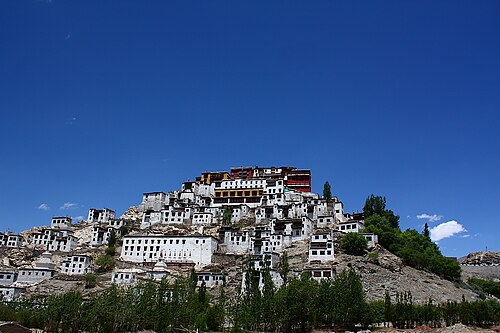 Thiksey Monastery or Thiksey Gompa (also transliterated from Ladakhi as Thikse, Thiksay or Tikse) is a Buddhist monastery affiliated with the Gelug school of Tibetan Buddhism. It is located on top of a hill in Thiksey approximately 19 kilometres (12 mi) east of Leh, in the Ladakh region of northern India. It is noted for its resemblance to the Potala Palace in Lhasa, Tibet, and is the largest monastery in central Ladakh, notably containing a separate set of buildings for female renunciates that has been the source of significant recent building and reorganization.
Thiksey Monastery or Thiksey Gompa (also transliterated from Ladakhi as Thikse, Thiksay or Tikse) is a Buddhist monastery affiliated with the Gelug school of Tibetan Buddhism. It is located on top of a hill in Thiksey approximately 19 kilometres (12 mi) east of Leh, in the Ladakh region of northern India. It is noted for its resemblance to the Potala Palace in Lhasa, Tibet, and is the largest monastery in central Ladakh, notably containing a separate set of buildings for female renunciates that has been the source of significant recent building and reorganization.
The monastery is located at an altitude of 3,600 metres (11,800 ft) in the Indus Valley. It is a twelve-storey complex and houses many items of Buddhist art such as stupas, statues, thangkas, wall paintings and swords. One of the main points of interest is the Maitreya Temple installed to commemorate the visit of the 14th Dalai Lama to this monastery in 1970; it contains a 15 metres (49 ft) high statue of Maitreya, the largest such statue in Ladakh, covering two stories of the building.
Lamayuru Monastery
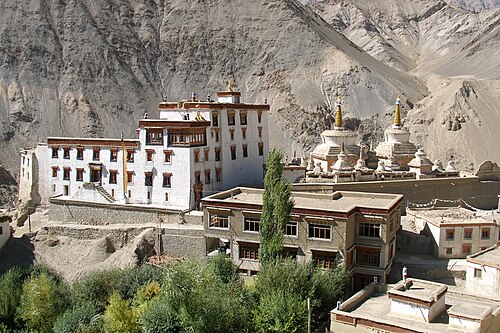 Lamayuru or Yuru Monastery is a Tibetan Buddhist monastery in Lamayouro, Leh district, Ladakh, India. It is situated on the Srinagar-Leh highway 15 kilometres (9.3 mi) east of the Fotu La at a height of 3,510 metres (11,520 ft) and 19 km southwest of Khalsi.
Lamayuru or Yuru Monastery is a Tibetan Buddhist monastery in Lamayouro, Leh district, Ladakh, India. It is situated on the Srinagar-Leh highway 15 kilometres (9.3 mi) east of the Fotu La at a height of 3,510 metres (11,520 ft) and 19 km southwest of Khalsi.
According to popular tradition, it was originally the foremost Bon monastery in Ladakh; its name means swastika and is a popular symbol in Bon culture for "eternity". Yungdrung is the name of the most popular school of Bon. It is currently affiliated with the Drikung Kagyu school of Buddhism.
Hemis Monastery
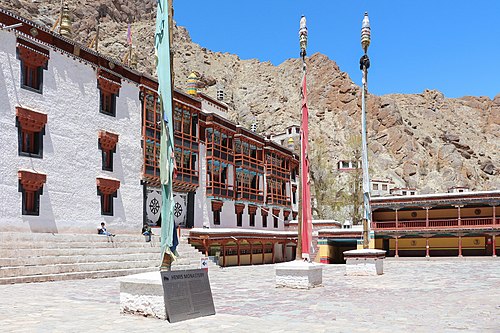 Hemis Monastery is a Himalayan Buddhist monastery (gompa) of the Drukpa Lineage, in Hemis on the bank of the Indus River, Ladakh, India. Situated 45 km from Leh, it was re-established in 1672 by the Ladakhi king Sengge Namgyal. The annual Hemis festival honouring Padmasambhava is held there in early June.
Hemis Monastery is a Himalayan Buddhist monastery (gompa) of the Drukpa Lineage, in Hemis on the bank of the Indus River, Ladakh, India. Situated 45 km from Leh, it was re-established in 1672 by the Ladakhi king Sengge Namgyal. The annual Hemis festival honouring Padmasambhava is held there in early June.
Hemis village is located 40 km southeast of Leh on Leh-Manali Highway and under-construction Bhanupli-Leh line.
Stok Monastery
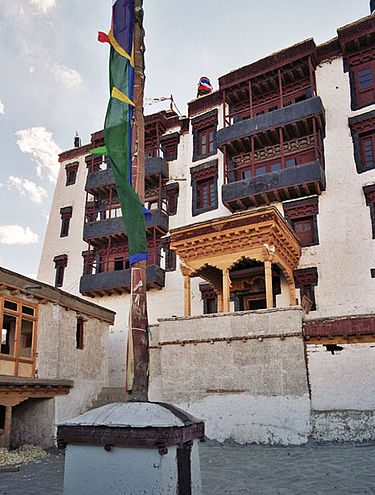 Stok Monastery or Stok Gompa is a Buddhist monastery in Stok, Leh district, Ladakh, northern India, 15 kilometres south of Leh. It was founded by Lama Lhawang Lotus in the 14th Century and has a notable library including all 108 volumes of the Kangyur. A ritual dance-mask festival is held annually.
Stok Monastery or Stok Gompa is a Buddhist monastery in Stok, Leh district, Ladakh, northern India, 15 kilometres south of Leh. It was founded by Lama Lhawang Lotus in the 14th Century and has a notable library including all 108 volumes of the Kangyur. A ritual dance-mask festival is held annually.
Next to the monastery is a 71-foot (22 m) high seated Gautama Buddha statue and temple, constructed between 2012-2015 and consecrated by the 14th Dalai Lama on 8 August 2016.
Around 2 km from the monastery is Stok Palace, built in 1820 as the summer home of Ladakhi royalty from the Namgyal dynasty of Ladakh.
Shey Monastery
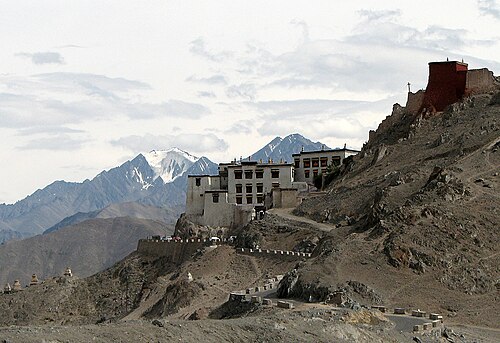 Shey Monastery or Gompa or the Shey Palace are complex structures located on a hillock in Shey, 15 kilometres (9.3 mi) to the south of Leh in Ladakh, northern India on the Leh-Manali road. Shey was the summer capital of Ladakh in the past. It contains a huge Shakyamuni Buddha statue. It is the second largest Buddha statue in Ladakh.
Shey Monastery or Gompa or the Shey Palace are complex structures located on a hillock in Shey, 15 kilometres (9.3 mi) to the south of Leh in Ladakh, northern India on the Leh-Manali road. Shey was the summer capital of Ladakh in the past. It contains a huge Shakyamuni Buddha statue. It is the second largest Buddha statue in Ladakh.
The original palace, now in ruins, was built near the Shey village by Lhachen Palgyigon, the king of Ladakh (then called Maryul), in the 10th century. The Moghul noble Mirza Haidar Dughlat stayed here during his invasion of Ladakh in the 16th century.
The current Shey Palace and Monastery were also built in 1655 on the instructions of Deldan Namgyal, in the memory of his late father, Sengge Namgyal, below the first palace. The monastery is noted for its giant copper with gilded gold statue of a seated Shakyamuni Buddha. The statue is so named since Buddha was the sage (muni) of the Sakya people who resided in the Himalayan foothills and their capital was Kapilvastu. It is said to be the second largest such statue in Ladakh.

